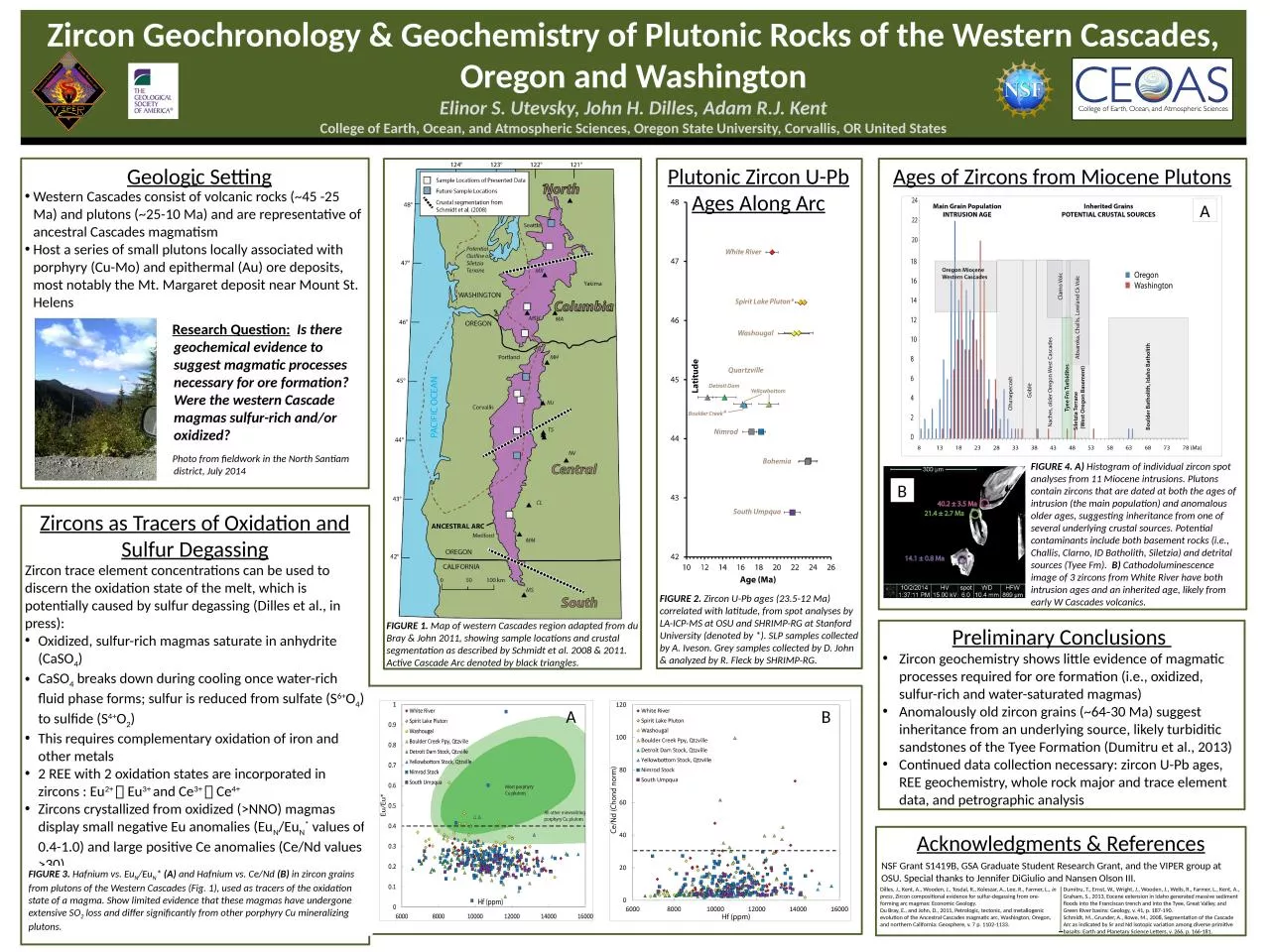

Tyee Great Valley and Green River basins Geology v 41 p 187190 Schmidt M Grunder A Rowe M 2008 Segmentation of the Cascade Arc as indicated by Sr and Nd isotopic variation among diverse primitive basalts Earth and Planetary Science Letters v 266 p 166181 ID: 1024520
Download Presentation The PPT/PDF document "Dumitru , T., Ernst, W., Wright, J., Woo..." is the property of its rightful owner. Permission is granted to download and print the materials on this web site for personal, non-commercial use only, and to display it on your personal computer provided you do not modify the materials and that you retain all copyright notices contained in the materials. By downloading content from our website, you accept the terms of this agreement.
1. Dumitru, T., Ernst, W., Wright, J., Wooden, J., Wells, R., Farmer, L., Kent, A., Graham, S., 2013, Eocene extension in Idaho generated massive sediment floods into the Franciscan trench and into the Tyee, Great Valley, and Green River basins: Geology, v. 41, p. 187-190.Schmidt, M., Grunder, A., Rowe, M., 2008, Segmentation of the Cascade Arc as indicated by Sr and Nd isotopic variation among diverse primitive basalts: Earth and Planetary Science Letters, v. 266, p. 166-181.Zircon trace element concentrations can be used to discern the oxidation state of the melt, which is potentially caused by sulfur degassing (Dilles et al., in press):Oxidized, sulfur-rich magmas saturate in anhydrite (CaSO4)CaSO4 breaks down during cooling once water-rich fluid phase forms; sulfur is reduced from sulfate (S6+O4) to sulfide (S4+O2)This requires complementary oxidation of iron and other metals2 REE with 2 oxidation states are incorporated in zircons : Eu2+ Eu3+ and Ce3+ Ce4+Zircons crystallized from oxidized (>NNO) magmas display small negative Eu anomalies (EuN/EuN* values of 0.4-1.0) and large positive Ce anomalies (Ce/Nd values >30)Zircon Geochronology & Geochemistry of Plutonic Rocks of the Western Cascades, Oregon and WashingtonElinor S. Utevsky, John H. Dilles, Adam R.J. KentCollege of Earth, Ocean, and Atmospheric Sciences, Oregon State University, Corvallis, OR United StatesPreliminary Conclusions Zircon geochemistry shows little evidence of magmatic processes required for ore formation (i.e., oxidized, sulfur-rich and water-saturated magmas)Anomalously old zircon grains (~64-30 Ma) suggest inheritance from an underlying source, likely turbiditic sandstones of the Tyee Formation (Dumitru et al., 2013)Continued data collection necessary: zircon U-Pb ages, REE geochemistry, whole rock major and trace element data, and petrographic analysisAcknowledgments & References Western Cascades consist of volcanic rocks (~45 -25 Ma) and plutons (~25-10 Ma) and are representative of ancestral Cascades magmatismHost a series of small plutons locally associated with porphyry (Cu-Mo) and epithermal (Au) ore deposits, most notably the Mt. Margaret deposit near Mount St. Helens FIGURE 1. Map of western Cascades region adapted from du Bray & John 2011, showing sample locations and crustal segmentation as described by Schmidt et al. 2008 & 2011. Active Cascade Arc denoted by black triangles.Research Question: Is there geochemical evidence to suggest magmatic processes necessary for ore formation? Were the western Cascade magmas sulfur-rich and/or oxidized? Photo from fieldwork in the North Santiam district, July 2014FIGURE 4. A) Histogram of individual zircon spot analyses from 11 Miocene intrusions. Plutons contain zircons that are dated at both the ages of intrusion (the main population) and anomalous older ages, suggesting inheritance from one of several underlying crustal sources. Potential contaminants include both basement rocks (i.e., Challis, Clarno, ID Batholith, Siletzia) and detrital sources (Tyee Fm). B) Cathodoluminescence image of 3 zircons from White River have both intrusion ages and an inherited age, likely from early W Cascades volcanics. ANSF Grant S1419B, GSA Graduate Student Research Grant, and the VIPER group at OSU. Special thanks to Jennifer DiGiulio and Nansen Olson III.Ages of Zircons from Miocene PlutonsGeologic SettingFIGURE 3. Hafnium vs. EuN/EuN* (A) and Hafnium vs. Ce/Nd (B) in zircon grains from plutons of the Western Cascades (Fig. 1), used as tracers of the oxidation state of a magma. Show limited evidence that these magmas have undergone extensive SO2 loss and differ significantly from other porphyry Cu mineralizing plutons. A BPlutonic Zircon U-Pb Ages Along ArcZircons as Tracers of Oxidation and Sulfur Degassing BDilles, J., Kent, A., Wooden, J., Tosdal, R., Koleszar, A., Lee, R., Farmer, L., in press, Zircon compositional evidence for sulfur-degassing from ore-forming arc magmas: Economic Geology.Du Bray, E., and John, D., 2011, Petrologic, tectonic, and metallogenic evolution of the Ancestral Cascades magmatic arc, Washington, Oregon, and northern California: Geosphere, v. 7 p. 1102-1133.FIGURE 2. Zircon U-Pb ages (23.5-12 Ma) correlated with latitude, from spot analyses by LA-ICP-MS at OSU and SHRIMP-RG at Stanford University (denoted by *). SLP samples collected by A. Iveson. Grey samples collected by D. John & analyzed by R. Fleck by SHRIMP-RG.